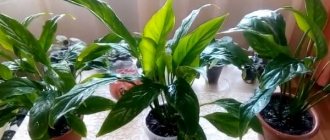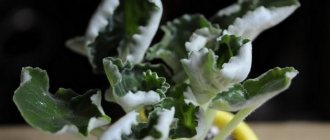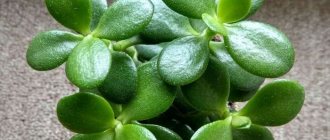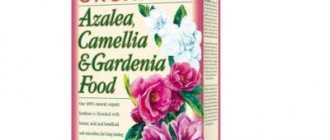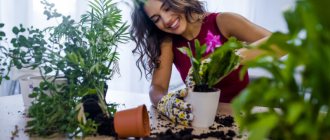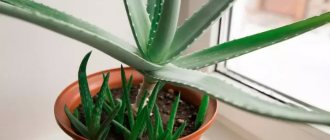Anthurium is a beautiful flower that was brought to our latitudes from the tropics. It is easily recognized by its large, heart-shaped leaves (up to 40 cm in length). The opened bud also has an interesting appearance: a flower ear in the center, surrounded by a bract of the same shape as the leaf blade. The plant is quite capricious, so this article will discuss why anthurium does not grow at home.
Causes of poor growth
The lack of development or its slow pace, as well as the impossibility of flowering, are associated with a number of reasons:
- improper lighting;
- inappropriate temperature – the flower does not like excess heat or cold;
- watering should also be at the proper level;
- the size of the pot does not correspond to the size of the anthurium root system;
- Inappropriate soil was selected for planting;
- there are not enough nutrients in the soil or fertilizing is carried out irregularly;
- the plant was transplanted in violation of the rules;
- the pot is often moved from place to place;
- the flower is in a draft;
- insufficient air humidity in the room;
- the presence of a large number of wilted buds on the plant;
- presence of pests or disease.
Next, we will describe in detail the most common causes and methods for eliminating them. By adhering to optimal growing conditions for anthurium, it will be possible to resume its growth and achieve flowering.
Diseases and pests
Like any plant, anthurium is susceptible to diseases and pests. It is important to know what kind of attack these or other symptoms indicate and take action in time.
Fungal infections
- Whitish or yellowish spots covering the leaves, grayish sporangia on the underside of the leaf are signs of infection with downy mildew. For treatment, you need to slightly dry the air in the room and treat the leaf tissue with a solution of a contact fungicide (Topaz, Acrobat).
- White spots on the leaves on top and dirty brown-red spots on the bottom indicate the appearance of rust. You need to get rid of it very quickly, before the leaves wilt; fungicides like Fitosporin will help.
- The appearance of a pinkish coating in the root zone and wilting of the leaves indicate infection with fusarium. The best way to combat it is prevention with antifungal drugs (Glyokladin), but if time is lost, you need to use Fundozol or Vitaros.
- Red spots with a yellow border, “decorating” the leaves, will tell about the appearance of septoria. To combat it, copper-based fungicides are needed, for example, Bordeaux mixture or copper sulfate.
- If the spots have a dark purple color, then we are talking about late blight infection. To prevent the death of the flower, treatment with systemic fungicidal preparations - Fitosporin-M, Fundazol, Previkur - is necessary. A transplant will be required with the obligatory replacement of the pot and contaminated soil and their sterilization. The roots of a diseased plant must be kept in a weak solution of potassium permanganate.
Pests
- If the leaves become sticky, sticky, curled and withered, aphids may have taken up residence on them. The plant needs a warm shower, treatment with laundry soap (mechanical removal of pests) and Antelin or another drug.
- The scale insect is similar to aphids. It is not difficult to recognize: tubercles appear on the leaves, which gradually darken. If you look closely, they move, feeding on the juices of the plant. Scale insects are removed mechanically, with a brush or cotton swab, laundry soap and kerosene are effective.
- If there is insufficient humidity, spider mites may appear on the anthurium. Signs of infection are small yellowish spots on the upper side of the leaf, and the lower side is covered with a thin cobweb with insects. The tick is removed with a soap solution, and the air humidity in the room is increased.
- Microscopic whitefly moths can destroy a plant if measures are not taken in a timely manner. The sticky coating from their secretions should be thoroughly washed off with soapy water, and the leaves should be treated with chemicals. For example, Aktara, Tanrek or others with the same effect.
Incorrect lighting
When trying to figure out what to do when anthurium is not growing well, the first thing you should pay attention to is lighting. The plant is distinguished by its love of sunlight, but does not tolerate prolonged exposure to direct rays on its leaves. In places where it grows naturally, the light of the sun passes through the foliage of trees, scattering sufficiently, so similar conditions must be created indoors.
A serious mistake is to install the pot in the sunniest place in the apartment. In this case, the leaf plate will get burns, turn yellow and fall off over time. A similar situation is observed when placed in the back of the room, where there is practically no light.
The ideal option for installing an anthurium pot would be a window on the west or east side of the house. This will allow you to receive a sufficient amount of lighting both in summer and winter. In the middle of the cold season, it would not be superfluous to organize artificial lighting.
Dividing the bush
This method is used only if the mother plant has reached the age of 3–4 years. Dividing the bush and planting the shoots is done in mid-spring, and the step-by-step process looks like this:
- half an hour before the start of the event, the mother bush is spilled generously with water;
- the plant is removed from the substrate, shaken slightly, excess soil is removed and the roots are carefully unraveled;
- if during unraveling some root shoots were damaged, then the wounds are immediately sprinkled with activated carbon or cinnamon;
- The plant must be divided in such a way that each part has a growing point and at least one leaf;
- rotted and severely damaged root shoots must be removed, leaving only healthy and viable ones;
- before rooting the shoots, they are left for 50–60 minutes in the open air to lightly dry the roots;
- shoots should be planted in such a way that the roots are buried exactly to the depth at which they were located in the old pot, being part of one plant;
- shoots that are too tall are tied to a support, which should be stuck into the substrate in advance - before planting the flower;
- for 2–3 months, new plants are sprayed weekly with Epin, Kornevin or Heteroauxin.
Air temperature
The development of the flower is adversely affected by the high ambient temperature in winter, when the dormant period begins, and subsequently the formation of buds occurs. The plant responds well to moderate heat, but not heat. During the cold season, the room should not be warmer than 20 degrees.
When understanding why anthurium does not grow, it is necessary to take into account that from the end of autumn the flower enters a dormant period, which lasts for 3 months. The ideal temperature at this time will be 15-17 degrees. Moderate coolness will ensure the shoots with buds are thrown out.
When flower stalks begin to form (usually mid-February), the room temperature should be at 18-20 degrees. In summer, the flower normally tolerates a range of 20-25 degrees.
Principles of cuttings
Cuttings taken from anthurium grow roots very quickly. As soon as the young roots reach a length of several centimeters, we plant new plants in containers in a permanent place and grow them, observing all care requirements.
Reproduction in this way consists of several stages:
- one leaf with a small piece of stem is separated from the mother bush; there should be a growing point on it;
- planting material should be 5-10 cm long;
- the stem is dried in the open air for several minutes;
- for better rooting and reduction of moisture loss, the leaf itself is usually removed;
- the prepared cutting is placed in moss, perlite, peat-sand mixture or simply in water;
- cover with polyethylene and place in a warm, shady place.
When answering the question of how to grow anthurium, you need to know that in some species it is possible to root even just a leaf. In this case, cut off the leaf plate with a small piece of the stem. The sheet is rolled into a tube and secured with thread and an elastic band. All this is placed in a small pot (glass) with moss or perlite; only a third of the leaf tube should protrude from the soil. The planting is watered and covered with film or a jar. The pot is placed in a warm place (about 25ºС) in the shade. Such a greenhouse must be ventilated daily and sprayed with warm, settled water. In such conditions, the plants develop quickly, and after about 20 days a sprout can be seen in the center of the tube, and after another month the young anthurium needs to be planted in its permanent place of “residence.”
During this period, it is better not to fertilize the plants: the small root system cannot absorb nutrients, but it is possible to get the roots burned. In this case, rotting of the root system may occur.
Errors in watering
A stop in development can occur due to excessive watering, when the water in the pot is constantly in a swampy state. The roots will rot, which will disrupt the nutrition of the entire plant. The lack of flowering may also be due to a lack of moisture in the soil. As in other details, the flower loves the golden mean.
Moistening the soil should be done after the top layer has sufficiently dried. A large amount of water can be added at a time, but the procedure itself should be carried out infrequently.
Water requirements: soft, not cold, without calcium salts. When using tap water, it should be left in a glass container for 5 days before applying to the soil. If you use a filter, then settling is not required. The liquid should be acidified once every 7-14 days: 1-2 drops of lemon juice per liter.
How to make anthurium bloom: tricks
Anthurium Andre - home care
If the anthurium has stopped blooming, what should you do after identifying the cause? First of all, take your time and approach the problem wisely.
Anthurium is a beautiful plant
Ready-made fertilizers
Feeding with ready-made complex mineral fertilizers, which were specially produced for anthuriums, will help make the bush bloom.
It is best to dissolve granular preparations in water and water the soil with it. Among dry fertilizers, “Forte”, “Fitosporin” and “Yantrain” help to bring the bush to normal condition.
Folk remedies
Even in the early stages of the problem, you can use traditional methods. You can make solutions for treating bushes at home, the main thing is to correctly calculate the proportions.
Flower growers resort to a little trick when the bush does not develop due to a disruption in the photosynthesis process. The formation of chlorophyll is disrupted due to a lack of lighting and iron, so you need to treat the soil with a solution of ferrous sulfate.
Note! If you spray the above-ground part of the bush with this solution, it will immediately visually take on a healthier appearance.
Anthurium is a flower with an amazingly beautiful appearance, the flowering of which is often suspended due to inattentive care. Therefore, you need to perform all activities regularly, following certain rules.
Pot
If the anthurium does not grow or bloom, an unsuitable pot may be to blame. The rhizome of the flower develops poorly, since it is an epiphyte. Such plants are always uncomfortable in deep pots. It is better to choose a container with a larger diameter than depth.
Of course, if grown for a long time, the plant may outgrow its pot. This is indicated by roots that appear under the top layer of soil or in the drainage holes below. The new container should be only 2-3 cm larger in diameter.
Landing technology
Before you start replanting, water the plant well and wait about 15 minutes - this is enough for the roots to be freely removed from the flowerpot. If they sit too tightly in the flowerpot, you can tap the edges. Next, the root system is inspected for rot, root death and the presence of pests. If everything is in order and the plant is developing, then do not change the soil - just transfer it to a larger pot, and add new soil from the sides.
If the roots show signs of rotting, you will have to take a number of measures:
- Remove old soil by rinsing them under running warm water.
- Trim damaged areas.
- Treat the sections with crushed activated carbon tablets or cinnamon.
Did you know? The name "anthurium" is a combination of the Greek words "Anthos" (flower) and "Ora" (tail). Literally - “flower with a tail.”
Next, proceed to planting in another container. Any drainage is placed on the bottom: polystyrene foam, broken brick, expanded clay. Approximately 1/3 of the container is needed for drainage. Then there is a layer of earth about 3 cm, on which a ball of roots is placed. The sides are filled with fresh soil. To retain moisture, you can lay sphagnum on top. You can plant a plant for the purpose of propagation using a shoot, which is carefully separated from the mother flower. The landing pattern is the same.
Lack of fertilizing
The problem of poor growth can be observed due to the lack of fertilizing, untimely application or use of an inappropriate composition. Nutrients should be added to the soil of the plant during the period of its active development - in spring and summer.
The flower is fed once a month with acidic compounds that do not contain calcium. The best choice would be liquid fertilizers specially produced for flowers. You can also use improvised means to increase acidity. For example, place pine needles or sphagnum moss under the base of the anthurium.
Selection of ready-made soil
Despite the wide range of ready-made substrates in gardening stores, choosing a soil mixture specifically for plants of the Araceae family is not so easy. However, some manufacturers still have in their line soils intended for indoor plants with increased requirements for air permeability and moisture capacity.
- Forpro is a well-known brand that produces ready-made soil mixtures specifically for anthuriums. The main components of this substrate are birch charcoal, high peat, larch bark and perlite. This composition is quite enough for delicate exotics to feel good, receive sufficient nutrients and fully develop.
- Rich Land is a large brand that offers consumers ready-made, high-quality soil mixtures for anthuriums. The substrates of this brand are well balanced and have the required acidity level: 4.5–5.5 pH. The high content of organic components in such mixtures creates optimal conditions for the growth and flowering of the exotic “male happiness”.
- “Gardens of Aurica” is a popular brand among gardeners that produces ready-made substrates and substrate components for representatives of the Araceae family, which includes anthuriums. The substrate mixture of this brand includes turf soil, pine bark and pine needles, sphagnum moss and sand. To provide the capricious exotics with the best living conditions, the manufacturer enriches its mixtures with complex mineral and potassium fertilizers.
Other reasons
Sometimes it is possible to determine the reason why anthurium does not grow after measuring air humidity. The plant does not tolerate excessively dry air, so it should be sprayed several times a day with plain water. The leaves themselves can be wiped with a damp cloth - this will provide additional moisture and allow you to remove a layer of settled dust.
An incorrectly selected composition of purchased soil can also have a negative impact on plant growth. It is almost impossible to achieve flowering of anthurium if it is planted in a substrate suitable for the bromeliad families of flowering plants or cacti. A peat mixture will not work either. The soil should allow oxygen to pass through and be slightly acidified. A good option would be a mixture for orchids.
The presence of a large number of wilted buds on the bush takes away the plant’s strength, which is spent on forming seeds. The faded bud should be cut off with a sharp knife or scissors.
Transfer
It is necessary to replant Men's Happiness systematically, but this must be done correctly and carefully so as not to damage the root part of the plant.
A flower brought from a store moves to a new flowerpot about two weeks after purchase. There is no need to be afraid that it continues to bloom - if the anthurium is comfortable, then it blooms all year round. The need is explained by the tightness of the original pot.
Subsequently, young plants are replanted every spring, after 3-4 years - as necessary, once every two years.
Pot
To replant a flower, you need to select a flowerpot that is slightly larger than the old one. Ideally, a finger should fit between the side of the pot and the root ball. It is a mistake to believe that a spacious flowerpot will allow anthurium to grow and bush better. On the contrary, the risk of excessive soil moisture, root rot, and disease will increase.
Priming
The correct substrate is the basis for the beauty and health of anthurium:
- The soil should be loose, light and heterogeneous - this ensures sufficient aeration of the root system and complete, but not excessive, moisture.
- The substrate contains crushed pieces of tree bark, coal, moss, peat, sand, and coconut fibers. The pH is slightly acidic, close to neutral – 5.5-6.
- Before planting the plant, the soil must be sterilized (put in the oven or in a water bath at a temperature of 800).
- You can use special mixtures for orchids, modifying their composition if necessary.
Landing
The anthurium is replanted using the transshipment method, carefully removing it from the old pot so as not to damage the root ball. You can add a layer of expanded clay to the bottom of the flowerpot as drainage, but this is not a necessary condition.
Place the root ball on a 3-4 cm thick peat cushion and carefully fill the pot with soil, tamping it lightly. The planting should not be deep. The space around the stems is smoothed with pieces of sphagnum.
The transplanted flower is watered, and after 15 minutes the excess water is drained from the pan.
